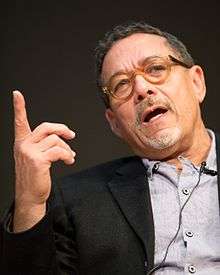Edouard Duval-Carrié
Edouard Duval-Carrié (born 1954) is a Haitian-born American painter and sculptor.
Edouard Duval-Carrié | |
|---|---|
 Edouard Duval-Carrié in 2014 | |
| Born | 1954 |
| Nationality | Haitian-American |
| Alma mater | Loyola College, Montréal, École Nationale Supérieure des Beaux-Arts |
| Known for | Painting, Sculpting |
| Website | Official website |
Life
Edouard Duval-Carrié was born in Port-au-Prince. His family emigrated to Puerto Rico during the François Duvalier regime, while he was a child.[1] Duval-Carrié studied at the Université de Montréal and McGill University in Canada before graduating with a Bachelor of Arts from Loyola College, Montréal in 1978. He later attended the École Nationale Supérieure des Beaux-Arts in Paris, France, from 1988 to 1989. He resided in France for many years and currently lives in Miami, Florida.[1] "I didn't want to go back to Haiti because of the political turmoil there. I have two kids," he explains.[1] Instead, he resides among Miami's substantial Haitian immigrant population and maintains cultural ties to his homeland.[1] His works have been exhibited in Europe and the Americas.[2]
Work

Duval-Carrié's art reflects the culture and history of Haiti with references to the Vodou religion.[1] His work is often overtly political, executed in attempts to embody his nation's spirit and its troubles with an attitude that is neither detached nor ironic.[1][3] His 1979 work J.C. Duvalier en Folle de Marié (Jean-Claude Duvalier as Mad Bride) is a criticism of the country's controversial leader.[1] Later in Mardigras at Fort Dimanche Duval-Carrié juxtaposes Duvalier against a torture chamber, an army general, and other symbols of the repressive regime.[1] New York University classified his output as magical realism for an event to accompany the book launch of Continental Shifts: The Art of Edouard Duval-Carrié, which was published by the university's press.[4] He operates in a variety of media: altarpieces, lacquered tiles, and reliquaries in addition to painting and sculpture.[3] Installations have become more prevalent in his recent output.[1]
As Duval-Carrié explained his artistic motivations for a Miami art gallery:
I have tried to analyze the historical context of the genesis of that partial island nation [Haiti], looked at the strife and suffering that brought the then society of slaves and slave masters to the point of ebullition. I look closely at the savagery on both parts of the struggle, understanding and giving my total sympathy to the downtrodden, not realizing that patterns are easily learned and extremely resilient to alteration... I have scrutinized the successive generations of pathetic leaders and their sordid entourages... But that is politics and an artist should be well cautioned to keep at bay that kind of poetry, which should be resumed as that of futility. So a step further or a level deeper was reached when the fabulous world of spirits, old and new, true and false, real and imagined, made themselves felt at different planes of consciousness. They come under many names, all quite entrancing. “Loas”, “Espirits”, or “Mysteres” all conveying a sense of foreboding inspiring the nebulousness from whence they come.[5]
Duval-Carrié's work was exhibited at the "Ouidah '92" festival, which celebrated Vodun art from Benin and the African Diaspora in Ouidah, Benin in February 1993.[6] Duval-Carrié received a South Florida Cultural Consortium Visual Art Fellowship in 1995 and a Southern Arts Federation Visual Art Fellowship in 1996.[7] His work has been shown in solo exhibitions in Haiti, the Dominican Republic, Colombia, France, Mexico, and in several states of the United States.[7] Two of the artist's works are displayed as public commissions in Miami: a 1996 piece for the Jefferson Reaves Rehabilitative and Health Center and The Lady of Miami at One Miami Riverwalk.[7]
Museum exhibits
The following museums contain works by Duval-Carrié in their collections.
- Figge Art Museum, Davenport, Iowa
- Grinnell College Museum of Art, Grinnell, Iowa
- Museum of Art Fort Lauderdale
- Museum of Contemporary Art North Miami[8]
- Pérez Art Museum Miami
- Musee des Art Africains et Oceaniens, Paris
- Musée du Panthéon National Haïtien, Port-au-Prince, Haiti
- Museo de Arte Contemporaneo de Monterrey, Monterrey, Mexico
- The Detroit Institute of Arts[9]
- Polk Museum of Art, Lakeland, Florida
- Musée du College St. Pierre, Port-au-Prince, Haiti
- Boca Raton Museum of Art
- Young At Art Museum, Davie, Florida[10]
References
- Kristin G. Congdon and Kara Kelley Hallmark (2002). Artists from Latin American Cultures: A Biographical Dictionary. Greenwood Press. pp. 74–76. ISBN 978-0-313-31544-2. Retrieved 2009-05-09.
- Le monde caraïbe: défis et dynamiques: p544 Christian Lerat, Université Michel de Montaigne-Bordeaux III. Pôle de recherche interdisciplinaire Caraïbe plurielle - 2005 "Ensemble avec le cinéaste Jonathan Demme (qui adapta à l'écran Beloved, de Toni Morrison31), avec Édouard Duval-Carrié (un peintre qui vit à Miami), Marilene Phipps, Myriam Chancy, Marie-Hélène Laforest, et les « Fugees » (Wyclif Jean),"
- Matt Schudel (22 June 2003). "Haitian artist Edouard Duval-Carrie exhumes memories of his homeland". Miami Sun-Sentinel. Retrieved 2009-05-09.
- "Continental Shifts: The Art of Edouard Duval-Carrié Book Launch at NYU, Mar. 27". New York University. 2008-03-04. Retrieved 2009-05-09.
- Edouard Duval Carrié. "Artist Statement". Bernice Steinbaum Gallery. Archived from the original on 2009-02-17. Retrieved 2009-05-09.
- Rush, Dana (Winter 2001). "Contemporary Vodun Arts of Ouidah, Benin". African Arts. UCLA James S. Coleman African Studies Center. 34 (4): 33. JSTOR 3337805.
- Edouard Duval Carrié. "Résumé". Bernice Steinbaum Gallery. Archived from the original on 2009-02-17. Retrieved 2009-05-09.
- https://mocanomi.org/2018/06/edouard-duval-carrie/
- https://www.dia.org/art/collection/object/untitled-43194
- Coppola, John (18 May 2012). "Artist Edouard Duval Carrie branches out but keeps roots in Miami". The Miami Herald. Retrieved 1 August 2012.
- Schutt-Ainé, Patricia (1994). Haiti: A Basic Reference Book. Miami, Florida: Librairie Au Service de la Culture. p. 111. ISBN 0-9638599-0-0.